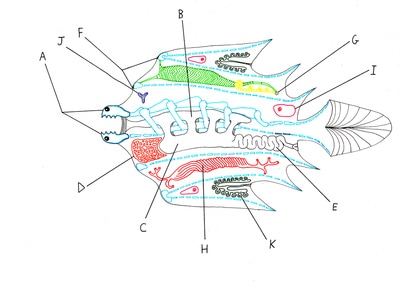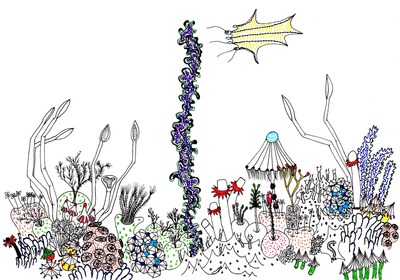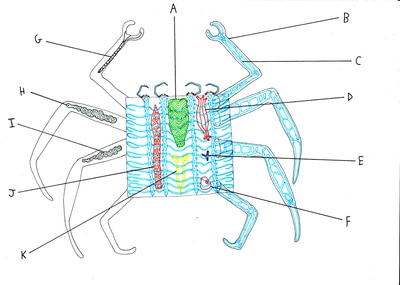|
Spec evo, short for speculative evolution, is a subgenre within science fiction that focuses heavily on the biology, ecology, or evolutionary history of living organisms.
It can further be divided into at least three subsubgenres. Some spec evo covers the future evolution of life on Earth, sometimes telling grand epics that cover billions of years as humans or descendants of other animals colonize other planets. Common themes include culture, religion, and extinction. Other spec evo covers alternate universes wherein history on Earth ran differently. The most common scenarios involve dinosaurs surviving the Cretaceous-Paleogene extinction event, or synapsid reptiles remaining dominant after the Permian-Triassic extinction event. Other spec evo covers the biology of life not from Earth. Some of the more detailed publications cover biochemistry and cellular structure. Others cover organ systems. Others cover environmental adaptations and ecological relationships. Some cover them all. This last type of speculative evolution is also referred to as astrobiology, xenobiology, or exobiology. Astrobiology is also the term used for serious speculation among scientists about life on other planets, while xenobiology and exobiology tend to be the dominant terms for the purely fictional side of things. All of these forms of literature are often accompanied by artwork. More about spec evo, including links to books, movies, and webpages, can be found at FloraAndFaunaOfTheUniverse.com
0 Comments
Life is hard to define, so how will we know when we have found life on other planets?
Fire grows, produces “offspring,” and consumes food, but it is generally not considered alive. Crystals also grow and produce offspring. Viruses are nothing but large molecules that interact with cellular machinery on contact to reprogram it to make more viruses. They can be thought of as alive, but they can equally be thought of as signaling molecules, such as pheromones or hormones. Within the nuclei of all eukaryotic cells are stretches of DNA that sometimes get themselves copied and inserted elsewhere in the genome. They are like internal viruses. Are they alive? Some definitions of life include homeostasis, the ability of an organism to maintain itself in different environments. Fire is temporary, existing only when conditions are right and until the fuel is used up. In contrast, wolves sense when they are hungry and seek out prey. Of course, wolves are temporary too, and cannot exist in the vacuum of space or on the surface of pulsars. Seen over long enough timescales, even the entire biosphere on Earth is temporary, expected to die a couple billion years from now. Some definitions include having complex biochemical cycles, with compounds being replenished from their own products. Of course, there are also simple cycles, such as what occurs in the “traffic light solution.” Pigment A converts to pigment B, which converts to pigment C, which converts back to pigment A, in a cycle that continues as long as the base reactants (which could be thought of as food) last. Is the solution alive? Some definitions include reproduction, but this excludes mules and sterile worker ants. If on another planet there was an ecosystem so closely symbiotic that it resembled a single organism that never reproduced, would we recognize it as alive? What if it talked to us? Some definitions include having a replicator capable of following the Darwinian algorithm. This means it must duplicate information with a high enough degree of fidelity so as not to quickly degenerate into non-life, but not so high that mutations do not occur, giving natural selection something to act on. In other words, life must evolve. This definition excludes self-replicating machines designed so precisely that they never make mistakes. It would also come as a surprise to the ancients, who thought they knew what life was, but had never considered evolution. More recently, some attempts have been made to describe life in mathematical terms, giving astrobiologists five specific things to look for: If an object maintains a gradient of compounds out of equilibrium with its environment, it might be alive. If the sizes of the objects under study follow an inverse power law, with smaller ones more common than bigger ones, they might be alive. If one molecule is activated only by one other molecule, as if they were lock and key, they might have been produced by life. If the molecules present require many unique steps to manufacture, rather than simply being repeating polymers, they might be produced by life. If the molecules present are asymmetrical and not accompanied by their mirror-image partners, they just might be produced by life. Life is hard to define, but the more qualifications a phenomenon holds, the more willing scientists are to call it life. So far, they have only found life on Earth. We must keep looking. Further Reading: https://www.scientificamerican.com/article/the-search-for-extraterrestrial-life-as-we-dont-know-it/ YouTube user Artifexian, who creates videos covering a variety of subjects, including languages, has created a playlist of helpful tips to make scientifically credible worlds for your creatures to live in. Subjects include climates maps, geology, orbital mechanics and how they relate to any calendars your beings might create, plant color, and much more. Watch it here.
The free online magazine Astrovitae features artists, projects, and individual organisms from all across the speculative biology genre, stretching it to include even drawings of reimagined mythical creatures. They currently publish twice per year. The layout and graphics are professional, but most of the content is contributed directly from the artists without editing. They write about themselves, their goals, their attitudes towards art, but mostly about the life forms, and that’s what it’s all about.
Curious Archive is a YouTube channel covering an eclectic bunch of subjects including history, cryptids, myths, and speculative biology in all its flavors. It is doing what I had hoped for this blog to do, shining a light on spec projects and encouraging art. If you need inspiration to start your own project, watch the videos sometime. Serina is as good a place to start as any.
YouTube user Phrenotopia, who creates videos covering a variety of subjects, including alternate history, science in fiction and popular culture, reviews, and biology, has created a playlist detailing how animal life is thought to have arisen on Earth. It is a good beginner’s guide to different bodyplans and embryology, as well as providing speculation on what patterns of biological evolution are likely to be seen on other planets – and which are not. It is a good resource if you are just getting started trying to develop plausible alien animals. Watch it here.
Your mission in this game is to explore planet ARY-26 to make sure it is suitable for human colonization. Catalogue animals, plants, and...er...plantimals. The creators can explain it better than I can. Visit SavagePlanetGame.com
The Conceptual Evolution Forum is where you can connect with other speccers, posting about your own projects and commenting on others. Get feedback on aesthetics and scientific plausibility from thousands of people all over the world. There are different sections to discuss future evolution on Earth, what might have happened on Earth had evolution run differently, evolution on other planets, and other universes where the laws of physics are different. Popular projects include Nemo and Sagan4. Register and say hello.
Evolution is a board game of strategy. Each of 2-6 players maintains one or more species that feed from a shared watering hole. To remain alive through the player’s turn each species must take in enough food for their body sizes and population sizes. Those that do not go extinct. Phenotype cards can be combined to alter each species to make it better at getting food. Sometimes, this means becoming a carnivore that can only attack other species for food. Some traits include defenses against predation. When the card stack is empty, the game is over and the player with the most food wins. I want to play this sometime.
Species is less of a video game than an evolution simulation program. One can simply sit back and watch creatures adapt and speciate or one can introduce selection pressures to see what happens. Challenge yourself to evolve something resilient. Among other things, players can change the oxygen levels, temperature, sea levels, and radiation. Changes in terrain can force creatures to expend more calories in order to move. Specific attributes can be added to the gene pools of any population, including not only shape and color, but sex drive, the maximum genetic distance allowable for successful mating, and metabolism – affecting secondary traits such as how often they sleep and how much food they need to keep from going extinct. The software tracks phylogenetic history to produce cladograms and comes with a DNA toggle board. It looks awesome.
Spore is a computer game of five levels. First, the player creates a unique aquatic microbe that must survive the hardships of nature. Continual tweaks can help it to better thrive in its environment. Next, it becomes a land-based creature. Next, it develops social groups. Next, it develops technology. Finally, it colonizes space and this level is played against other empire-builders online. I can’t rate it because I’ve never played – I don’t have time or patience to learn structured games – but it sounds fun.
If you are a world builder who needs to ground your life form designs in scientific plausibility, the podcasts at BEKernWrites.com are a good place to start. Each runs about forty minutes long. Subjects such as biomes, metamorphosis, metabolism, and genetic material are covered by an actual professor of biology. The lectures stick pretty close to describing Earth life most of the time while briefly mentioning some of the variations found across the galaxy. It is not wildly speculative.
If you need some guidance in creating scientifically accurate and plausible habitats and organisms for your exobiology project, the Speculative Evolution Wiki is a great resource to start with. There is a page on the types of alien planets thought to exist. There is a page on alternative biochemistries. There are pages covering the wide variety of approaches Earth life takes to common problems, such as movement, perception, reproduction, defense, and the various ways that an organism might draw energy from its environment.
|
Like alien art? Check out my store.
Copyright © 2017



 RSS Feed
RSS Feed